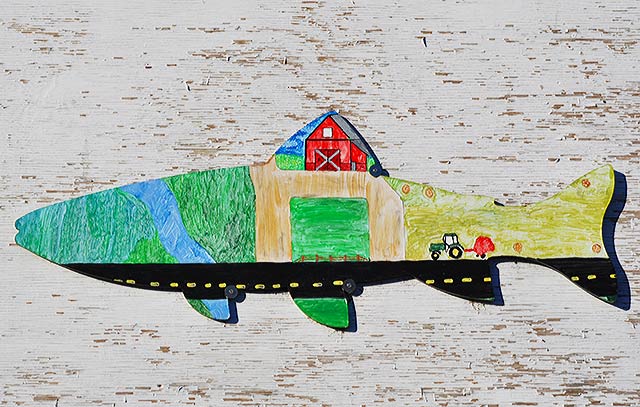A Sand County River-Poem
An old English professor of mine used to tout the benefit of selecting one book to reread ritualistically each year, no excuses, the same book each and every year until your grains of sand ran out. For him that book was King Lear; he read it every winter, and come springtime you’d find him marveling at how, having read it some forty-plus times, he still managed to find something unexpected and epiphanic and new.
The text I read every year is a short length of Wisconsin river located on the northern fringe of Aldo Leopold’s sand counties. It’s the trout stream on which I’d like to say I cut my trout fishing teeth, whereas in reality those teeth cut me. The Central Sands region, as it is commonly referred to, is no country for young men, or inexperienced fly anglers of any age. Fish populations are on the low side compared to the spring creeks to the southwest, and pursuing what sparse quarry exists is complicated by the fact that the water is clear as turpentine and the riverbed is made up of sand—endlessly unfurling monochromatic sand. The unusually self-aware trout of this region know just how well their leopardine spots blend into a sand bottom, which is to say not at all, and are skittish beyond repair. The best advice I’ve ever gotten on fishing these rivers? Fish at night, in the rain, or someplace else.
It was daytime and lightly snowing when I fished there this past week. March is a good time to get some river-reading done, at least in central Wisconsin; the banks are heaped with snow and shelved in ice and the farm machinery is hibernating—a world without distractions save the occasional snowflake smearing your sunglasses. I crunched through the bankside snow upstream, slithered into the water and immediately started surveying, skimming and parsing.
Fishing some rivers—big brawny freestoners and tailwaters—is like reading a novel. You fish them in a boat, covering many miles of river, beating the banks in a rhythmic zone wherein the pages of the day’s story fall away at a steady, dependable rate. There is a luxury and fecundity in these large rivers, these expansive narratives. Lost and missed fish need not be lamented—countless others await. At the end of the day the large-river angler feels a sense of accomplishment that comes from having conquered, if not apprehended, something formidable.
Other rivers read like short stories. These are the shorter streams, the tributaries, informed by the same geological plot the whole way through. This water is wadeable and comes furnished with plenty of room to cast. Fish- and structure-wise, there is enough opportunity for the angler to enjoy the trout-like luxury of being selective, focusing, if he or she pleases, on a particular element—say, heads of holes—then choosing a fly and method and hopscotching from one incarnation to the next.
Then there are waters, like my diminutive Sand County stream, that ask to be fished like a poem. Covering water is not really an option: thick bankside alders force you into the water, where you don’t so much wade as crepitate if you want to keep from kicking huge clouds of sand downstream. As for structure, there are no long, even passages to get lost in, no textbook tongue-throat-pool sequences or nymph-me-now current seams to focus on. It is total and unpredictable free verse, full of mischievous mis- and re-direction, enjambed currents and eddying caesuras, moments of clarity (a shimmering riffle) and moments of opacity (a sudden, stark hole).
In my early angling days I read this and all water pretty much the same way: quickly and arrogantly. I knew what I was looking for—or thought I knew—and would skip through the paragraphs until I found it. I didn’t catch many fish, though I fished hard and long. Now I’m of the mind that fishing long and hard doesn’t catch you fish. But riverine literacy, patience, and intensity of focus do.
This is an invitation to be a more thoughtful, literate angler. Whatever your homewater, next time you’re out take time to understand each word and stone, each line break and current seam, each riseform and metaphor before moving on. Don’t go looking to find meaning; rather, go looking to pay atttention. Meaning—and trout—will be revealed.












